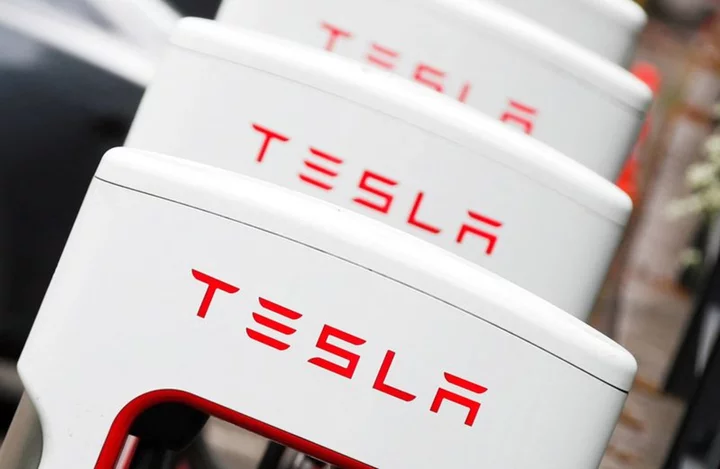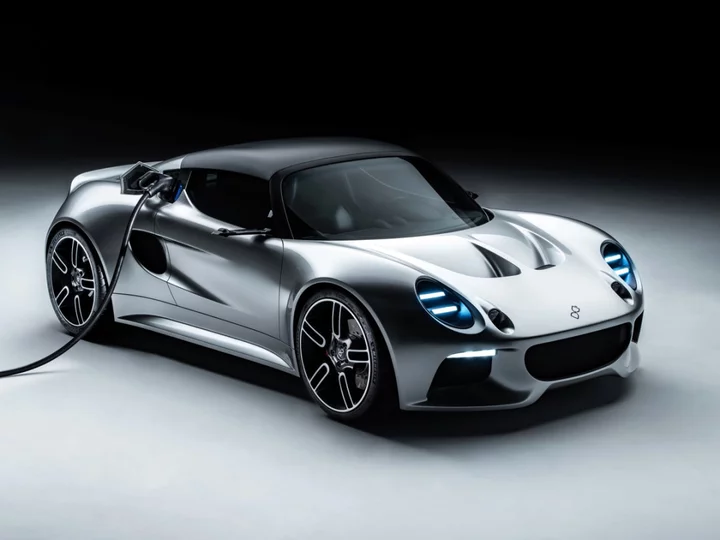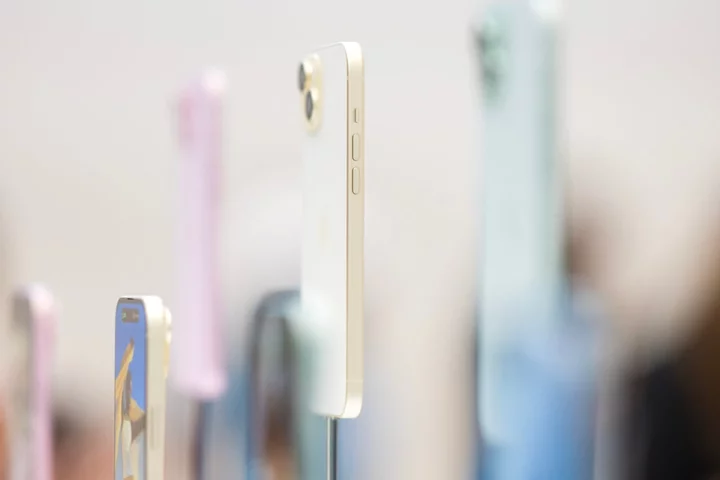
The Girl With the Green Ribbon: A Grisly History of ‘Headless Woman’ Stories
Precursors to the story about the girl with the green ribbon were written by Washington Irving, Alexandre Dumas, and more famous authors.
2023-09-19 01:24

Tesla, Saudi Arabia in early talks for EV factory - WSJ
(Reuters) -Saudi Arabia is in early talks with U.S. electric automaker Tesla to set up a manufacturing facility in the
2023-09-19 01:18

Arm Holdings options draw robust trading volume as shares slide
By Saqib Iqbal Ahmed NEW YORK Options on the newly listed shares of SoftBank's Arm Holdings, the year's
2023-09-19 01:16

Amazon set to hire departing Microsoft product chief Panay - Bloomberg News
Amazon is set to hire Microsoft's departing product chief Panos Panay, Bloomberg News reported on Monday, citing sources
2023-09-19 01:16

Activision Executives Were Briefed on New Nintendo Switch Last Year
Activision Blizzard Inc. executives were briefed on a next-generation console from Nintendo Co. as early as 2022, according
2023-09-19 00:56

Verizon executive testifies Google search always pre-installed on mobile phones
By Diane Bartz WASHINGTON The U.S. Justice Department on Monday questioned a Verizon executive about the company's decision
2023-09-19 00:23

Battery prices plummet as electric cars approach ‘tipping point’
The cost of batteries fell by nearly 10 per cent in August, taking them past a key milestone that is seen by energy analysts as a “tipping point” to supercharge the transition to electric vehicles. The price of lithium-ion battery cells, which power everything from smartphones to the International Space Station, fell below $100/ kilowatthour (kWh) last month – a 33 per cent drop from March 2022 and an 8.7 per cent month-on-month drop. Energy analytics firm Benchmark Mineral Intelligence, who compiled the figures, noted that battery pack prices need to reach $100/kWh for electric vehicles to reach price parity with fossil fuel-burning vehicles. “Decreasing cell prices could allow [manufacturers] to sell mass market electric vehicles at comparable prices to internal combustion engine vehicles, with the same margin, improving the attractiveness of the EV transition for both consumers and automakers,” said Benchmark analyst Evan Hartley. “Falling cell prices are of particular concern for companies investing in cell production outside of China, particularly when there is already concern surrounding the profitability of factories in regions such as Europe.” The drop in price could also have implications for other technologies, the report noted, including for solar and wind installations that need to store excess energy during periods of overproduction. “The energy and transport revolution continues,” energy analyst Gerard Reid wrote on LinkedIn. “Lithium battery cell prices are now below $100 per kWh, down 80 per cent in a decade. Going forward we will see even lower costs and better performance, which is why the death of the internal combustion engine is near.” The falling prices have been attributed to decreasing raw material costs, with lithium prices more than halving since the start of 2023. The price could continue to fall following the discovery of massive lithium deposits in recent months, most notably within an extinct supervolcano on the border of Nevada and Oregon. The McDermitt caldera could contain up to 120 million tonnes of lithium, according to recent estimates from geologists, which could potentially meet global battery demand for decades. Read More Battery breakthroughs are about to trigger a transport revolution Volcano discovery could power electric cars for decades, scientists say New invention will lead to ‘battery revolution’, scientists say Volcano discovery could power electric cars for decades, scientists say Scientists invent solar panels that work in a snow blizzard
2023-09-19 00:22

How Many People Play Apex Legends in 2023?
Apex Legends' average monthly player count hovers around 65,000,000 players in 2023, with over 66,000,000 people playing Apex Legends in August 2023.
2023-09-18 23:25

Benjamin Netanyahu is expected to confront Elon Musk about antisemitism on X Monday
Israeli Prime Minister Benjamin Netanyahu is set to meet with X owner Elon Musk on Monday, where he is widely expected to confront Musk on his social media platform's handling of antisemitism.
2023-09-18 23:16

FC 24 Champions Rewards Changes: Red Player Picks Removed
EA FC 24 Champions rewards received a major change by removing red player picks from the default rewards lineup.
2023-09-18 23:15

Chip startup UltraSense enters deal with Korean automotive supplier
By Stephen Nellis UltraSense Systems, a Silicon Valley startup that makes a chip that can replace mechanical buttons,
2023-09-18 22:27

iPhone 15 Pro: How Apple made the smartphone into a camera like none before it
The iPhone is a lot of things. It's a social networking portal, it's a games console – sometimes it's even a phone. For Apple's Jon McCormack, Apple's vice president for camera software engineering, it's "primarily a camera that you can text from". It wasn't always this way. When Steve jobs introduced the iPhone in 2007, he famously described it is an iPod, a phone and an internet communications device; the first iPhone had a camera, new iPhones are cameras. The pictures that first iPhone turned out were more useful than beautiful. Today, however, the iPhone's pictures have grown up, and it is now the most popular camera in the world. Now the question is how sharp the pictures should be, and there has even been some criticism that the pictures it turns out are too sharp, if anything. The iPhone's camera is no longer just a useful addition but is used in professional contexts, and is often given as the main reason to upgrade to new models. The new iPhone 15s, in particular the premium Pro and Pro Max, continue Apple's mission to turn its smartphones into cameras like nothing in the history of photography. They have new image formats, the addition of extra focal lengths, and the iPhone 15 Pro Max even includes a 5x lens that makes use of a "tetraprism" lens that bounces light around inside the phone to add dramatically more zoom without making the phone any bigger. All of that additional hardware works in collaboration with improved software: users no longer have to click into portrait mode, for instance, because the camera automatically captures depth information when taking a picture of people, so that background blur can be added and edited even after the photo has been taken. Apple has also added a host of features that many people are unlikely ever to even look at, let alone use, but are important to professionals. They include the addition of Log encoding and the Academy Color Encoding System – both key to those who need them. Apple also says that the new iPhone has "the equivalent of seven pro lenses", despite really only having three; what they mean is that you can choose different crops, which is in part an attempt to appeal to those professional photographers who stubbornly say that they will only ever work with a 50mm lens, for instance. (Those new lens choices are not only a cropped version of the existing lenses, says McCormack, since the phone also has custom neural networks specifically designed to optimise images at that focal length.) Those complex new features are a reminder that the iPhone is many things to many users: some may simply want to remember important events, or snap pictures of their pets. Others might be truly professional photographers, needing to rely on their iPhone to capture valuable and fleeting events. Some people are, no doubt, both – and Apple is aware that the iPhone has to be both, too. "For us, what we feel is really important – especially since computational photography started to blur the line between hardware and software, and really enable anybody to take stunning shots with minimal effort – is making sure that that tool that we have in your pocket is adapting to your needs," says Maxime Veron, Apple's senior director for iPhone product marketing. "So if you're just trying to take a quick photo of your kids can get out of the way and just allow you to do that. And if you want to create a professionally created Hollywood style video, it can also give you the customisation and the power to do that." McCormack says that Apple builds the camera from "the core belief that everybody has got a story that is worth telling". For some people that story might be their child taking their first steps, captured in a video that will be shared with only a few people. Or it might be a photojournalist taking images that are going to be shared with millions. "Our belief is that your level of technical understanding shouldn't get in the way of you being able to tell that story," he says. High-end cameras have often required their users to think about a whole host of questions before they even get to actually pressing the button to take a picture: "the temperature of light, the amount of light, the direction of light, how fast is the subject moving? What are the skin tones?" notes McCormack. "Every second that you spend thinking about that, and playing with your settings and things like that, are seconds that you are drawn out of the moment," he says. "And what we want to create is this very deep connection between the photographer, the videographer and the moment." He points to the action button on this year's Pro models, which can be programmed to launch the camera with a push. "It's all about being able to say all of this crazy complexity of photography, or videography – Apple's taken that, and understood that, and hidden that from you," he says. "You as a photographer, you get to concentrate on the thing that you want to say, and finding that decisive moment, finding that beautiful framing, that says the thing that you want to say. "But the motivation for all of this and using all of this crazy, great computational photography, computational videography, is that we don't want to distract you from telling the story that you want to tell." That has meant building the iPhone's camera in a way that the features "unfold", he says. "Out of the box, we are going to give you an amazing thing that is going to cover most of your moments, with lots of dynamic range, lots of resolution, zero shutter lag, so you can capture the moment. "But of course, there are folks who are going to look at this and say, you know, I've got a very specific and very prescriptive vision," he says. He points to a variety of new tools that are built into the phone, such as the ProRAW format, which makes huge files and is not especially useful to most – but can be key to someone who really wants to ensure they are able to process every detail of a photograph after it is taken. Those are hidden within settings, there for the people who need them but not troubling those who don't. Veron also notes that many of those extra features are enabled by "an amazing ecosystem of third party partners" who make apps that allow people to get features they are looking for. It is a reminder of just how much is going on as soon as someone takes a picture with the iPhone. First, light travels through one of Apple's three lenses and hits a 48 megapixel sensor – but that's just the beginning of a long process of computational photography that analyses and optimises that image. The picture that is taken is not just the one image, for example: it is actually made up of multiple exposures, with more or less light, that can then be merged into a picture with the full dynamic range. "This year for the first time, we merge them in a larger resolution," says McCormack. It takes one image in 12 megapixels, to give a fast shutter speed and plenty of light, by combining pixels together; then it grabs a 24-megapixel frame, which collects the detail. "Then we register those together and use a custom machine learning model to go and transfer the detail from the 48 over into what has now become a 24." That creates something like the negative in old camera terms, which the iPhone’s processor can then get to work on, using parts of its chip focused on machine learning. "We use the neural engine to go decompose that photograph, bit by bit." It will notice if people have different skin tones, and develop those parts of the image accordingly; hair, eyes, a moving background and more are all taken to pieces and optimised on their own. (The intensity of that process has occasionally led to questions over whether the phone is working too hard to make its images look good.) Then there's yet more work for the camera system. The iPhone uses tonemapping to ensure that images pop on the bright screens of modern iPhones, but also that they still look bright on a compressed image that might be sent around the internet; one of the many changes that smartphones have brought to photography is that, for the first time, the photos are mostly looked at on the same device they were taken with, but that they can also be sent and seen just about anywhere. If the image is taken using night mode, then there's even more work, with new tools that ensure that colours are more accurate. And that isn't even mentioning portrait mode, which when it registers that there is a person (or a pet) in the frame will gather the relevant depth information to ensure that the background can be manipulated later. That whole process – those five paragraphs, and thousands of calculations by the phone – happen within the tiniest moment after pressing the button to take the photo. The phone may look as if it is serenely offering up an image to its users, but it has been busily working away in the background to ensure the picture is as accurate and vibrant as possible. All that work done by the camera and the rest of the device depends on a variety of choices made not only by the iPhone but by Apple, which accounts for the look of the modern iPhone picture – Veron says that its aim in making those decisions is to make "beautiful, true-to-life memories in just one click". McCormack is clearly keenly aware of the responsibility of that task; his vision decides what the world's memories look like. "This is your device that you carry with you all time the time, and we want to be really, really thoughtful of that," he says. That responsibility carries into the design of the camera within the phone: rumours had suggested that this year's model would include a "periscope" design for the long zoom, bouncing the light through the length of the iPhone, but McCormack says that Apple went for the five-way prism to ensure that it could "both retain the industrial design that we want, to just make iPhone feel so good in your hand, but also be able to get that extra focal length". "It is just of one of those crazy things – only Apple is going to do something like that. And I'm really glad that that's the way we think about product." Read More Tim Cook says Vision Pro release is on track: ‘I watched Ted Lasso Season 3 on it’ Apple Store goes offline as Apple opens pre-orders for iPhone 15 Apple to update iPhone 12 after fears over radiation iPhone 12 is not emitting dangerous radiation, Apple says, amid fears of Europe ban France’s iPhone 12 ban could spread across Europe, regulators say Everything Apple killed off at iPhone 15 event
2023-09-18 22:27
